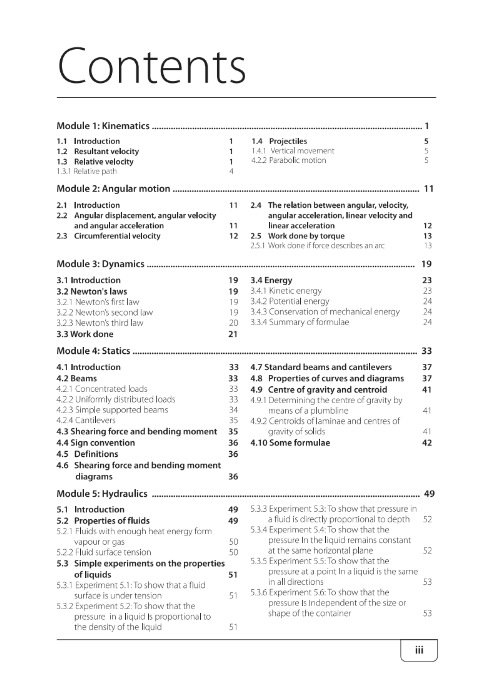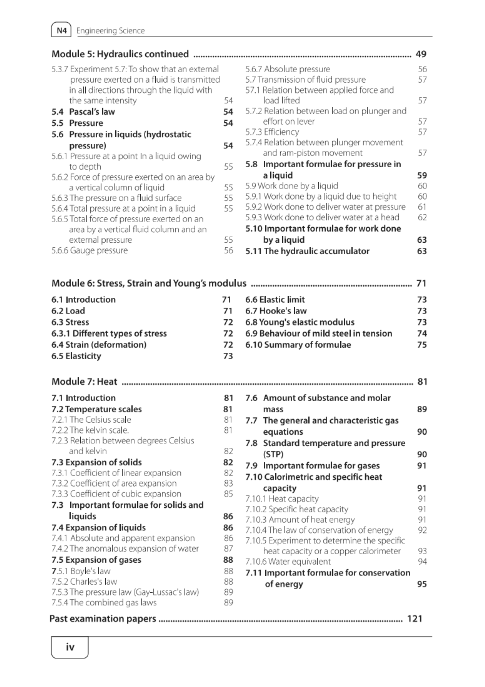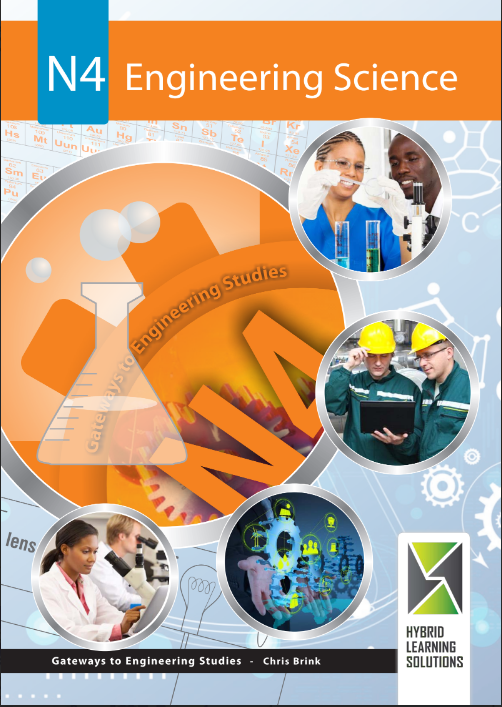


Contents
Module 1: Kinematics 1
1.1 Introduction 1
1.2 Resultant velocity 1
1.3 Relative velocity 1
1.3.1 Relative path 4
1.4 Projectiles 5
1.4.1 Vertical movement 5
1.4.2 Parabolic motion 5
Module 2: Angular motion 11
2.1 Introduction 11
2.2 Angular displacement, angular velocity and angular acceleration 11
2.3 Circumferential velocity 12
2.4 The relation between angular, velocity, angular acceleration, linear velocity and linear acceleration 12
2.5 Work done by torque 13
2.5.1 Work done if force describes an arc 13
Module 3: Dynamics 19
3.1 Introduction 19
3.2 Newton’s laws 19
3.2.1 Newton’s first law 19
3.2.2 Newton’s second law 19
3.2.3 Newton’s third law 20
3.3 Work done 21
3.4 Energy 23
3.4.1 Kinetic energy 23
3.4.2 Potential energy 24
3.4.3 Conservation of mechanical energy 24
3.3.4 Summary of formulae 24
Module 4: Statics 33
4.1 Introduction 33
4.2 Beams 33
4.2.1 Concentrated loads 33
4.2.2 Uniformly distributed loads 33
4.2.3 Simple supported beams 34
4.2.4 Cantilevers 35
4.3 Shearing force and bending moment 35
4.4 Sign convention 36
4.5 Definitions 36
4.6 Shearing force and bending moment diagrams 36
4.7 Standard beams and cantilevers 37
4.8 Properties of curves and diagrams 37
4.9 Centre of gravity and centroid 41
4.9.1 Determining the centre of gravity by means of a plumbline 41
4.9.2 Centroids of laminae and centres of gravity of solids 41
4.10 Some formulae 42
Module 5: Hydraulics 49
5.1 Introduction 49
5.2 Properties of fluids 49
5.2.1 Fluids with enough heat energy form vapour or gas 50
5.2.2 Fluid surface tension 50
5.3 Simple experiments on the properties of liquids 51
5.3.1 Experiment 5.1: To show that a fluid surface is under tension 51
5.3.2 Experiment 5.2: To show that the pressure in a liquid b proportional to the density of the liquid 51
5.3.3 Experiment 5.3: To show that pressure in a fluid is directly proportional to depth 52
5.3.4 Experiment 5.4: To show that the pressure in the liquid remains constant at the same horizontal plane 52
5.3.5 Experiment 5.5: To show that the pressure at a point in a liquid is the same in all directions 53
5.3.6 Experiment 5.6: To show that the pressure is independent of the size or shape of the container 53
iii
N4 Engineering Science
Module 5: Hydraulics continued 49
5.3.7 Experiment 5.7: To show that an external pressure exerted on a fluid is transmitted in all directions through the liquid with the same intensity 54
5.4 Pascal’s law 54
5.5 Pressure 54
5.6 Pressure in liquids (hydrostatic pressure) 54
5.6.1 Pressure at a point in a liquid owing to depth 55
5.6.2 Force of pressure exerted on an area by a vertical column of liquid 55
5.6.3 Total pressure on a flat surface 55
5.6.4 Total pressure at a point in a liquid 55
5.6.5 Total force of pressure exerted on an area by a vertical fluid column and an external pressure 55
5.6.6 Gauge pressure 56
5.6.7 Absolute pressure 56
5.7 Transmission of fluid pressure 57
5.7.1 Relation between applied force and load lifted 57
5.7.2 Relation between load on plunger and effort on lever 57
5.7.3 Efficiency 57
5.7.4 Relation between plunger movement and ram-piston movement 57
5.8 Important formulae for pressure in a liquid 59
5.9 Work done by a liquid 60
5.9.1 Work done by a liquid due to height 60
5.9.2 Work done to deliver water at pressure 61
5.9.3 Work done to deliver water at a head 62
5.10 Important formulae for work done by a liquid 63
5.11 The hydraulic accumulator 63
Module 6: Stress, Strain and Young’s modulus 71
6.1 Introduction 71
6.2 Load 71
6.3 Stress 72
6.3.1 Different types of stress 72
6.4 Strain (deformation) 72
6.5 Elasticity 73
6.6 Elastic limit 73
6.7 Hooke’s law 73
6.8 Young’s elastic modulus 73
6.9 Behaviour of mild steel in tension 74
6.10 Summary of formulae 75
Module 7: Heat 81
7.1 Introduction 81
7.2 Temperature scales 81
7.2.1 The Celsius scale 81
7.2.2 The Kelvin scale 81
7.2.3 Relation between degrees Celsius and Kelvin 82
7.3 Expansion of solids 82
7.3.1 Coefficient of linear expansion 82
7.3.2 Coefficient of area expansion 83
7.3.3 Coefficient of cubic expansion 85
7.3 Important formulae for solids and liquids 86
7.4 Expansion of liquids 86
7.4.1 Absolute and apparent expansion 86
7.4.2 The anomalous expansion of water 87
7.5 Expansion of gases 88
7.5.1 Boyle’s law 88
7.5.2 Charles’s law 88
7.5.3 The pressure law (Gay-Lussac’s law) 89
7.5.4 The combined gas laws 89
7.6 Amount of substance and molar mass 89
7.7 The general and characteristic gas equations 90
7.8 Standard temperature and pressure (STP) 90
7.9 Important formulae for gases 91
7.10 Calorimetric and specific heat capacity 91
7.10.1 Heat capacity 91
7.10.2 Specific heat capacity 91
7.10.3 Amount of heat energy 92
7.10.4 The law of conservation of energy 92
7.10.5 Experiment to determine the specific heat capacity or a copper calorimeter 93
7.10.6 Work equivalent 94
7.11 Important formulae for conservation of energy 95
Past examination papers 121
iv
Engineering Science N4
We use different icons to help you work with this book; these are shown in the table below.
Icon
Description
Icon
Description
Assessment / Activity
Multimedia
Checklist
Practical
Demonstration / Observation
Presentation/ Lecture
Did you know?
Read
Example
Safety
Experiment
Site visit
Group work/ discussions, role-play, etc.
Take note of
In the workplace
Theoretical questions, reports, case studies, etc.
Keywords
Think about it
v
Module 1 Kinematics
Learning Outcomes
On the completion of this module the student must be able to:
Solve problems dealing with linear motion analytically where external factors such as wind and water are concerned; a maximum of three simultaneous motions are examined.
Solve analytical problems relating to practical situations where two objects move horizontally at constant velocity in different directions.
Determine the results velocity, shortest distance, time, intersection, overtaking and actual velocity.
Solve analytically problems that deal with projectiles which are launched vertically or at an angle other than 90° to the horizontal.
1.1 Introduction
Kinematics is a part of the science of mechanics is the study of pure motion which is irrespective of the force that causes it.
1.2 Resultant velocity
Resultant velocity is the sum of two or more velocities which have simultaneous influence on the object. It can be described as the effective velocity in a given direction. It is therefore the velocity of the object relative to earth or ground surface.
Resultant velocity occurs:
• When a passenger walks along the corridor of a moving train and has two simultaneous velocities.
• When a sailor walks across the deck of a yacht sailing over a flowing river.
• When a plane flies in a moving air mass or wind.
Definition: Resultant velocity
Resultant velocity simply refers to the sum of all vectors. It is calculated by adding two velocities in the same direction using the Pythagorean theory. A good example would be a plane flying amidst a tailwind. When you add the velocities of the tailwind and the plane, what you get is known as resultant velocity.
Gateways to Engineering Studies


